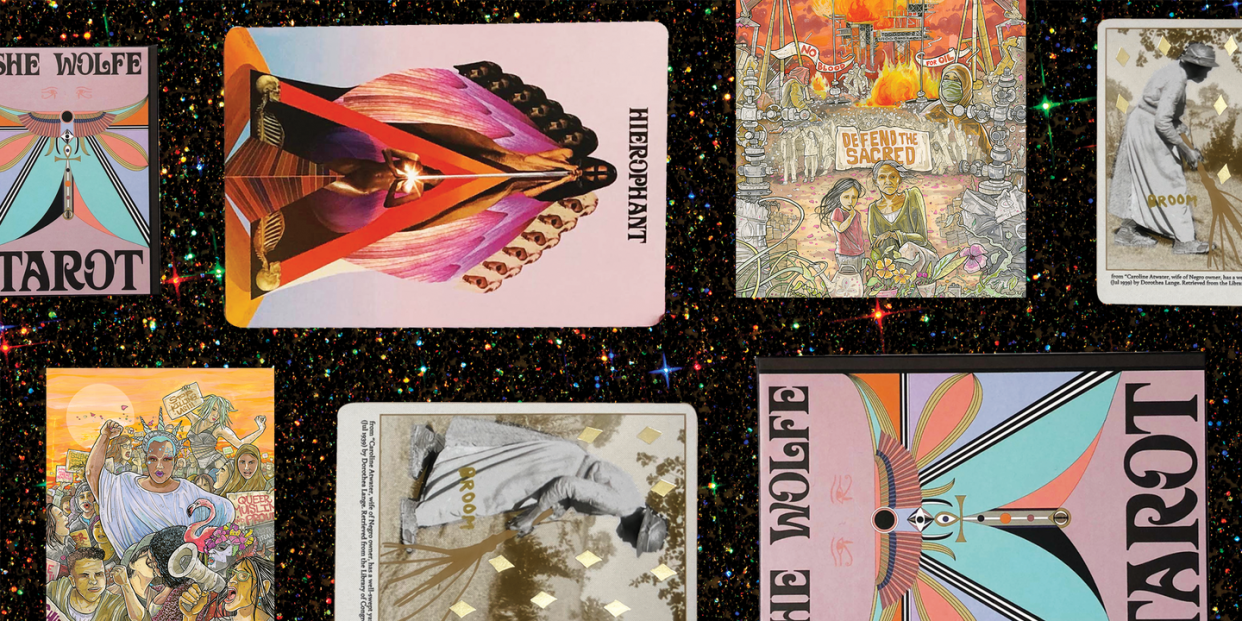These Unique, Inclusive Decks Are Changing What Tarot Looks Like

Until fairly recently, to think of the tarot was to think of a fortune-teller cliché: a crystal ball, cards like Death or the Hanged Man, maybe a velvet robe giving off whiffs of incense. But these divination tools have gotten a glow-up. Artists are taking on the task of translating the ancient cards into a self-care tool with imagery that reflects who we are, and what we aspire to be, right now.
“I think communing with my Black ancestors is a very personal experience, and I wanted a personal deck to reflect that specific experience for me,” says Tea, the artist behind The Black Gold Lenormand. Lenormand cards are a type of oracle deck similar to the tarot’s Minor Arcana—think of it like a deck of playing cards loaded with symbolic images, such as Mice, or Ring, or Mountain. Tea’s Lenormand uses old, sepia-toned photos of Black people from sources such as the Library of Congress that bring emotion to the deck, and feel electric with unknown history and story. Snake features a sideshow performer from the 1930s playfully giving a snake a bite; Broom depicts a woman bending to sweep her rural yard. Tea ornamented her Kickstarter-funded deck with accents of golden ink, giving each card the feeling of an enchanted object.
Although tarot's roots go back over 500 years, the Rider-Waite-Smith deck—the most commonly-used tarot deck today—was first published in 1909. All the people shown on the cards, from the Seven of Pentacles to the Emperor, are white—and in cards that show couples, such as the Lovers or the Two Of Cups, they're all straight. For way too long, this and its niche-y derivatives were all that was available.
But in recent years, tarot sales have skyrocketed—in 2017, they reached a 50-year high, according to the New York Times, and sales have only continued to increase. Shoppers now have countless options when choosing a deck: Amazon's featured new releases include a Nightmare Before Christmas deck, a deck inspired by director Guillermo del Toro, and a DIY tarot that you can color in. The availability of crowdsourcing sites such as Kickstarter have made it possible for first-time BIPOC, queer, and feminist tarot creators to put their visions into print.
Today’s focus on the representation of intersectional identities in media has impacted tarot; it’s only natural that a tool designed to be an intimate reflection of our personal growth accurately reflect who we are.
Devany Amber Wolfe is the creator of the Serpentfire oracle deck and She Wolfe tarot decks; her cards feature modern psychedelic feminine imagery and are influenced by astrology and the ancient Egyptian pantheon. She was moved to tell the story of the tarot—the archetypal "Fool’s Journey" that plays out in the cards—in her own femme-centric way. “I felt this was necessary, because the traditional tarot is patriarchal,” she says.
By offering pre-orders of decks-in-progress on crowdfunding sites, artists are able to raise the capital to get their work into print, and get their finished product into the hands of the people who nurtured the project into existence. Courtney Alexander, creator of the striking, luminous Dust 2 Onyx Tarot, was motivated by a desire to see a tarot deck that centered Black figures and was actually created by a Black artist—something very rare even a few years ago, when she started her Kickstarter campaign. She also had an aesthetic drive to work with “Blackness as a color story," she says. "It represents the essence of Blackness, of dark matter, of the Universe. Black is the inclusion of everything—all colors together create Black.”
The process of creating a deck that illuminates classically underrepresented communities sometimes becomes a community project in itself. Artist Cristy C. Road set her Next World Tarot in the ruins of our current culture, a post-apocalyptic fantasia notable for being one of the only utopian visions of Armageddon I’ve ever seen. It's also a spectacular showcase for the radically political portraiture she’s known for. Road worked with her models to add elements of their faith and into the images, taking inspiration from Hindu deities, elements from African diaspora traditions, and Road's own Santería heritage.
“In the beginning it was a queer tarot. I wanted a non-binary tarot that was also punk. Then it evolved into representing ancestral magic and elevating queer people of color. I was really eager to elevate people with disabilities, make sure that people had different bodies,” she says. The resulting deck does all of the above.
With so many decks to choose from, there has never been a better time to find a deck that speaks to your senses and get to work learning about this ancient tool for future-peeking and self-knowledge. As Wolfe advises, “Choose a deck that has artwork that speaks to you, and a comprehensive guidebook. Go with your instincts.”
You Might Also Like

